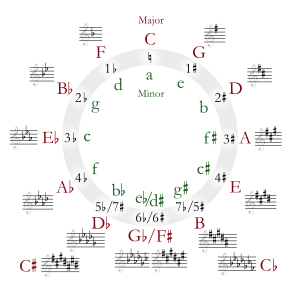Theoretical key facts for kids
In music theory, theoretical keys are special key signatures that have really unusual symbols called double-flats or double-sharps. Think of them as keys that are technically possible but are almost never used in real music.
Double-flats and double-sharps are like super-flats or super-sharps. They change a note by two half-steps instead of one. While you might see them sometimes next to a single note in a song, they are almost never put in the main key signature at the beginning of a piece. Why? Because it would make the music incredibly hard to read and play!
For example, the key of G♯ major is a theoretical key. Its key signature would need an F![]() . That's a lot of sharps! Luckily, in music that uses equal temperament (which is how most modern Western music is tuned), the G♯ major scale sounds exactly the same as the A♭ major scale. Keys that sound the same but have different names are called enharmonically equivalent. So, instead of writing a song in G♯ major, musicians usually write it in A♭ major because its key signature is much simpler to read.
. That's a lot of sharps! Luckily, in music that uses equal temperament (which is how most modern Western music is tuned), the G♯ major scale sounds exactly the same as the A♭ major scale. Keys that sound the same but have different names are called enharmonically equivalent. So, instead of writing a song in G♯ major, musicians usually write it in A♭ major because its key signature is much simpler to read.
Here's how the notes compare for G♯ major and A♭ major:
| G♯ major: | G♯ | A♯ | B♯ | C♯ | D♯ | E♯ | F |
| A♭ major: | A♭ | B♭ | C | D♭ | E♭ | F | G |
What is Enharmonic Equivalence?
Most Western music has a main home key. Sometimes, a song might modulate, meaning it temporarily shifts to another key. This new key is usually closely related to the home key. You can see how keys are related by looking at the circle of fifths.
When a key is near the top of the circle, it has few sharps or flats in its key signature. Changing to a nearby key is easy; you just add a few more sharps or flats. However, if the home key is near the bottom of the circle, it already has many sharps or flats. If you keep adding more, you'd end up with a key signature that's too complicated, needing double-sharps or double-flats. This is where enharmonic equivalence comes in handy. Musicians use the "easier" enharmonic key instead.
Why We Need to Think About Theoretical Keys
Even though theoretical keys are rarely used, understanding them helps musicians choose the simplest way to write music.
Some keys that are enharmonically equivalent can both be written without any double-sharps or double-flats. These are not considered theoretical keys. Here are a few examples:
| Major (minor) | Key signature | Major (minor) | Key signature | |
|---|---|---|---|---|
| B (G♯) | 5 sharps | C♭ (A♭) | 7 flats | |
| F♯ (D♯) | 6 sharps | G♭ (E♭) | 6 flats | |
| C♯ (A♯) | 7 sharps | D♭ (B♭) | 5 flats |
However, if a song changes to a key that is very far away on the circle of fifths, it might theoretically need so many sharps or flats that double-sharps or double-flats would appear in the key signature. These would be considered theoretical keys. For example, if a song in E major changes key up a perfect fifth to B major, it's simple: you just add one more sharp to the key signature. If it changes again to F♯ major, you add another sharp. The next change to C♯ major adds yet another sharp, making seven sharps in total.
But if it changed key one more time, it would theoretically become G♯ major. This key would need an eighth sharp, which would be a double-sharp for the F note. To avoid this complicated theoretical key, musicians would instead write the new section in A♭ major, which sounds the same but has a much simpler key signature.
| Diatonic Scales and Keys | |||||||||||||||||||||||||||||||||||||||||||||||||||||||
|---|---|---|---|---|---|---|---|---|---|---|---|---|---|---|---|---|---|---|---|---|---|---|---|---|---|---|---|---|---|---|---|---|---|---|---|---|---|---|---|---|---|---|---|---|---|---|---|---|---|---|---|---|---|---|---|
|
|||||||||||||||||||||||||||||||||||||||||||||||||||||||
| The table shows the number of sharps or flats in each scale. Minor scales are written in lower case. | |||||||||||||||||||||||||||||||||||||||||||||||||||||||
Images for kids


